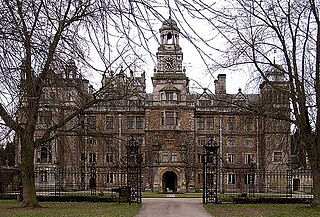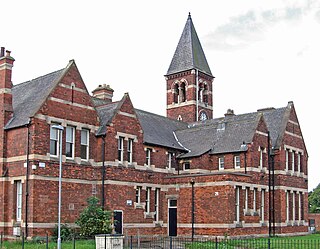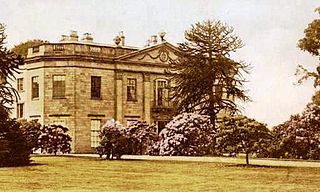
Duke of St Albans is a title in the Peerage of England. It was created in 1684 for Charles Beauclerk, 1st Earl of Burford, then 14 years old. King Charles II had accepted that Burford was his illegitimate son by Nell Gwyn, an actress, and awarded him the Dukedom just as he had conferred those of Monmouth, Southampton, Grafton, Northumberland and Richmond and Lennox on his other illegitimate sons who married.

Eleanor Gwyn was a celebrity figure of the Restoration period. Praised by Samuel Pepys for her comic performances as one of the first actresses on the English stage, she became best known for being a long-time mistress of King Charles II of England. Called "pretty, witty Nell" by Pepys, she has been regarded as a living embodiment of the spirit of Restoration England and has come to be considered a folk heroine, with a story echoing the rags-to-royalty tale of Cinderella. Gwyn had two sons by King Charles: Charles Beauclerk (1670–1726) and James Beauclerk (1671–1680). Charles Beauclerk was created Earl of Burford and later Duke of St Albans.

Charles Beauclerk, 1st Duke of St Albans, KG was an illegitimate son of King Charles II of England by his mistress Nell Gwyn.
Charles Francis Topham de Vere Beauclerk, also styled Earl of Burford by courtesy, is a British aristocrat and heir to the peerage title of Duke of St Albans.

The Dukeries is an area of the county of Nottinghamshire so called because it contained four ducal seats. It is south of Worksop, which has been called its "gateway". The area was included within the ancient Sherwood Forest. The ducal seats were:

Murray de Vere Beauclerk, 14th Duke of St Albans,, styled Earl of Burford from 1964 until 1988, is an English duke.

Charles Beauclerk, 2nd Duke of St Albans, KG KB was a British politician who sat in the House of Commons from 1718 until 1726 when he succeeded to a peerage as Duke of St Albans. He was an illegitimate grandson of King Charles II.
George Beauclerk, 3rd Duke of St Albans, styled Earl of Burford until 1751, was a British peer.

William Amelius Aubrey de Vere Beauclerk, 10th Duke of St Albans, PC DL, styled Earl of Burford until 1849, was a British Liberal parliamentarian of the Victorian era.

The Reverend Lord Frederick de Vere Beauclerk, a 19th-century Anglican priest, was an outstanding but controversial English first-class cricketer, the leading "amateur" player of the Napoleonic period.
Bestwood St. Albans is a former civil parish in the Gedling borough of Nottinghamshire, England. According to the 2001 census it had a population of 4,950. At the time of the 2011 census the population had increased to 5,259. The parish included the Bestwood Village and Bestwood Lodge areas, as well as Warren Hill, Warren Wood, Deer Park and 'The Gardens' on the northern outskirts of the Greater Nottingham conurbation, but not the area of Nottingham itself known as Bestwood.

Bestwood Village is an area and civil parish in the Gedling district of Nottinghamshire. Until 1 April 2018 it was part of the civil parish of Bestwood St. Albans. A small part of the village falls within the Ashfield district council area. There have been several new housing estates built recently including the redevelopment of the former Bayles and Whylie factory site which was a former glue mill. It is to the east of Hucknall and north of Bulwell. It is neighboured to the north by the village of Papplewick. It is also close to the Bestwood Park Estate which is in the City of Nottingham.

Lord Sidney Beauclerk was a British politician who sat in the House of Commons from 1733 to 1744. He acquired a reputation as a fortune hunter.
Events from the year 1668 in England.

Shipley Hall was a country estate in Shipley, Derbyshire near Heanor and Ilkeston which now forms a Country Park.

Bestwood Pumping Station was a water pumping station operating in Nottinghamshire from 1874 until 1964.

Vicar Water is a small river in Nottinghamshire, England. It is a tributary of the River Maun, and runs through an area which was once the royal hunting ground of Clipstone Park. It gained its present name in the early nineteenth century, and was dammed in 1870, in order to make a trout fishery, which was used to stock the lakes at nearby Welbeck Abbey. Since the cessation of coal mining, much of it has been incorporated into a country park, and is a designated Local Nature Reserve.

Bestwood Park is a large post-war council estate located to the north of the city of Nottingham, England, and roughly bounded by Beckhampton Road, Oxclose Lane and Queens Bower Road.

St. Albans is a civil parish in the Gedling borough of Nottinghamshire, England.
Bestwood St. Albans is a former civil parish in the Newark and Sherwood district of Nottinghamshire, England. The former parish contains 19 listed buildings that are recorded in the National Heritage List for England. Of these, four are at Grade II*, the middle of the three grades, and the others are at Grade II, the lowest grade. The former parish contains Bestwood Village and an area to the east. The listed buildings include a country house, later a hotel, and associated structures, smaller houses, a church and its lychgate, a water pumping station and associated structures, the winding house and headstocks of a former colliery, an office building, and a war memorial.


















